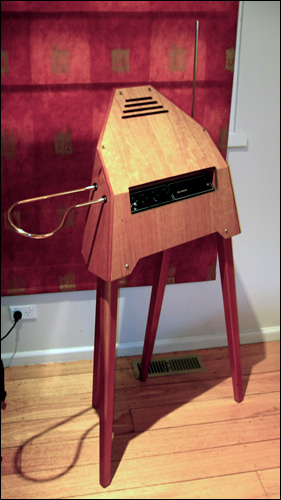Sun 3 May 2009
Copper
Posted by anaglyph under Hokum, Skeptical Thinking, Sound, WooWoo
[32] Comments
You may remember that, in the ‘wine horoscope’ post a few days back, I said that ‘hokum flourishes in places where there is a substantial amount of subjectivity and a stratosphere of opinionated ‘experts’’. Wine is not my field, so aside from pointing out the obvious ridiculous claims made by the wine sellers in that particular case, I’m not really qualified to comment on the mechanics of the business with any technical authority.
There is another field, though, that is rife with its own 101 Flavours of Claptrap that I am qualified to take on, and that is the mysterious club of ‘high end home audio’.
It’s hard to know where to start with ‘professional’ hi fi. There is so much misinformation and gobbledegook that pretty much wherever you turn there’s some implausible gadget or other for improving your sound, from gold-plated connectors, through pens that make CDs ‘clearer’ to (quite unbelievably) expensive wooden knobs* for your amplifier. And that’s not even tippy-toeing into the world of serious audio fruitcakes.
But today I’m going to examine the simplest, and perhaps the most exploited of all hi fi components: speaker cables. The hyperbole spouted by the vendors of these products is voluminous. Their ‘oxygen free, polarized di-electric, elevated-off-the-floor, cryogenically chilled’ cables will make your muddy cloth-filtered music sound like it’s been triple-washed in Persil! It’ll come out of the speakers at a fidelity beyond studio quality!
What’s going on here? Can some bits of wire really make that much difference? Well, yes and no. First of all there’s an important point to note about speaker cables – they carry a much higher level signal than anywhere else in the audio chain because it is amplified. In practical terms, what this means is that your actual modulated raw audio signal is at its most powerful going from your amp to your speakers. Why is that important? Because at this time the electrical signal is bumped up way beyond the noise level of all the other components in the system – most of the stuff that can be done to affect the fidelity of the signal itself has already been done.†
That being said, what becomes significant is the best way to get the electrical signal from out of your amp into your speakers with the least impediment possible, and this essentially comes down to one thing: providing the happiest and least reactive conduit for your excitable electrons to travel along. Now there are some mitigating factors involved: no matter how good your path is there is some wear and tear on how well the electrons fare. They are effected by the quality of the conductor, the distance they have to travel and other electrical phenomena such as capacitance and inductance. But here is the critical point: none of these are really much of a problem in ten feet of speaker cable. In addition, even if you were able to demonstrate some non-optimal electrical artifacts over such a short distance, it is unclear what effect, if any, these have in relation to audio fidelity.‡
So. What is the most important factor to consider in getting your electrical signal to your speaker? Just one thing: lots of copper. Copper is a terrific conductor of electricity. It’s very kind to the electrons as they pass though, giving them the easiest path to travel that they could ever want. And when we’re talking about ten feet, all being said, that’s really not that much copper.
I’m now going to give you a tip that will save you hundreds of dollars and make your hi fi system sound as good as the very nerdiest of your audio-buff friends: for your speaker connections, forget all about the oxygen free, diode rectified, dipped-in-chocolate, used-only-by angels $1000-per-foot Pear cables** and instead just use a good quality twin core electrical cable.

That’s it! Use some wire like this and no-one on the planet will be able to tell the difference between it and the most expensive cable you can buy! I found the stuff above for less than $2 a metre and you can do even better than that. Sum total for speaker cable for my studio: $45. And that’s for a full 5.1 sound set up, with 6 speaker sources.
Audio buffs like to pontificate ad nauseum about the how much difference the supposed ‘high end’ speaker cables make but to those of us who work in the business they just look like idiots – we don’t use those kinds of cables! So what these people are claiming is that they can hear better sound in the reproduction of the material than we heard when we made it! That, of course, is an absurdity of the highest order.
I’d like to end with a true story. Many years ago, a hi fi aficionado acquaintance of mine invited me around to hear his new system. He had spent many thousands of dollars on components, and waxed lyrically about his new speaker cables, which, he said, had improved the fidelity of his music by an impressive order of magnitude. Knowing about my skepticality of such claims, he swore that even I would notice! He sat me down and pressed play on one of his favourite jazz recordings. Could I perceive a superior sound quality? Was I astonished at the clarity of his sound? Well, not so much – I spent a more than a few minutes coming to grips with the fact that his speakers had been wired out of phase, a much more egregious degradation of the listening experience than even speaker leads made of string would have inflicted. And something that he had not even noticed.
I’m not suggesting that all hi fi buffs would make such an obvious mistake, but the thing is, my friend had invested so much money and faith in his audio gear that he had little choice but to believe that he was witnessing superior sound reproduction. And I do suggest that this phenomenon, like that which we saw at work in the ‘wine horoscope’ hoodwink, has more than a little part to play in influencing the subjective experience of listening to recorded music…
___________________________________________________________________________
*It seems pretty clear to me that the most significant knobs in this equation are the ones forking out the money. Seriously – read the blurb on the link to the ‘Silver Rock ‘Signature’ knobs and tell me that the manufacturers aren’t having a very good laugh at the silly hi fi twits’ expense. You’d be forgiven for thinking it really was a joke, if this very same company wasn’t selling speaker cables for over a thousand dollars…
†Excluding, of course, what is done by probably the most important component of all – the speakers themselves. But we’re not talking about speakers for the moment – that’s a whole other ballgame.
‡Another sign of the magical thinking involved in high end audio comes in the form of the following dichotomy: hi fi buffs will argue till they’re blue in the face that analogue sound is superior to digital sound. They insist that there is something called ‘warmth’ that comes from analogue that doesn’t make it into the digital world. Why, then, are they so happy to eschew the old, simple twin core speaker cable used on nearly every analogue hi fi system ever made up until about the late 1970s (when the hi fi craze really started to take off)? What if the old cables contributed to that warmth…? Paradoxes such as these are another flag for spotting pseudoscience.
**James Randi put forward his famous Million Dollar Challenge to the makers of Pear cables, to demonstrate in a double blind test that their product would outperform a cheap good quality cable of the same length. Predictably, after first calling the Challenge a hoax, and then (as is so often the way) resorting to ad hominem attacks against Randi, Pear’s CEO Adam Blake refused to participate. This is an unequivocal admission of flim flam. If your product performs as claimed, you can only come out of the Randi Challenge looking absolutely golden (with the added advantage of $1000,000 cash in your pocket). If you back out, then this surely indicates that you are afraid that the results will not bear out the hyperbole in your marketing. This, in turn, indicates that you are deluded or a swindler.
___________________________________________________________________________







